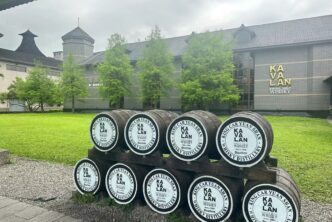Ettore Germano is a wine estate in Serralunga d’Alba that can boasts one of the most impressive lineups of wines of any winery in the Barolo denomination. In fact, a good case can be made that Ettore Germano doesn’t get the respect it deserves. While some Barolo producers would score 100 points (always from the same wine writers, of course) even if they were to bottle something that tasted of goat’s milk rather than Barolo, Ettore Germano hardly benefits from the same spotlight. Frankly, that says a lot more about the sorry state of the wine writing profession today than it does about Ettore Germano or the many other wineries of the area that aren’t being treated like others. To be crystal-clear, at Ettore Germano they make what most people (who actually know what they are talking about) consider to be Italy’s best Riesling wine (Hérzu); a number of Alta Langa bubblies that are far and away amongst the best of that denomination and amongst the more interesting sparkling wines made in Italy [and in fact, Germano was among the first producers who began making Alta Langa wines back in 2003 when there were only thirteen producers making these bubblies (seven wineries had launched the denomination originally)]; a Langhe Nascetta wine that is always excellent, year in and year out; and a bevy of Barolos from really top-notch sites that speak clearly of the site the grapes were sourced from and that age gracefully. I mean, read’em and weep: Prapò, Lazzarito and Vignarionda are amongst the top 15 crus of Barolo, and at Germano they have vineyards in other good sites too. In other words, when you buy a Barolo from Ettore Germano you are getting a Barolo that is made from a true grand cru or high-quality premier cru vineyard district, and not from the jokes that are some patches of land best suited to hazelnuts that have been nonetheless, culpably, been allowed MGA status.

Ettore Germano is run today by Sergio Germano and his likeable family. The estate was originally only four hectares large: it was born when Sergio’s father, Ettore, united the properties of Sergio’s grandfather Alberto and his brother Giovanni (sons of Francesco and Maria Germano). In 1975, Ettore went ahead and transformed the holdings in one big vineyard, doing away with other crops entirely. Originally, the land was mostly (75%) planted to Dolcetto, as it used to be almost everywhere in the Langhe back in the 1970s. Back then, Barolo wasn’t at all as popular as it is today. Germano used to sell his grapes mostly to private clients, though he usually sold his Nebbiolo grapes that came from sites allowed to make Barolo were usually sold to the bigger negozianti of the area. Ettore actually made some Dolcetto wine too, mostly for home consumption and for those friends that had stopped making wine on their own.
In 1985, Sergio began working at the family winery and it was thanks to his push too that in 1988 Ettore Germano began to estate-bottle. Sergio had graduated with a degree in Enology in 1985, and like all youngsters had novel ideas he wished to implement at the winery. But first he gained experience by working at other local wineries: in 1985 he followed the harvest at Fontanafredda, far and away Serralunga’s biggest wine reality: it’s a time he looks back on fondly, describing it as being “exciting and interesting”. After that, he had to comply with Italy’s then obligatory military service requirement, but managed to take care of it while working at the Ascheri winery (from 1987 al 1988). Then it was back to Serralunga, where he worked for six years at Batasiolo, with then winemaker Marco Monchiero. He finally came back to the family estate full-time in 1995, which in the meantime had grown by another two hectares.
Initially, Sergio worked with his father Ettore and his mother Rosanna. In 1997 he married Elena, whom he credits for being a huge help right from the beginning, given she took over all the administrative stuff that interested him less but that is time-consuming and requires a ton of attention. Their children, Elia (now 25 years old) and Maria (23 years old) have also begun to work at the winery: Elia follows the vineyards and during the winter also follows the foreign markets, while Maria is destined to be the estate’s future winemaker. It really is a family affair at Ettore Germano: just imagine that Sergio’s mom Rosanna still lives right there on the property, a little house in the Cerretta cru just a few steps removed from the winery building. Once in a while she will travel to Ticino to see her sister, but for the most part she enjoys coming to the winery every day by walking through her beloved vineyards.
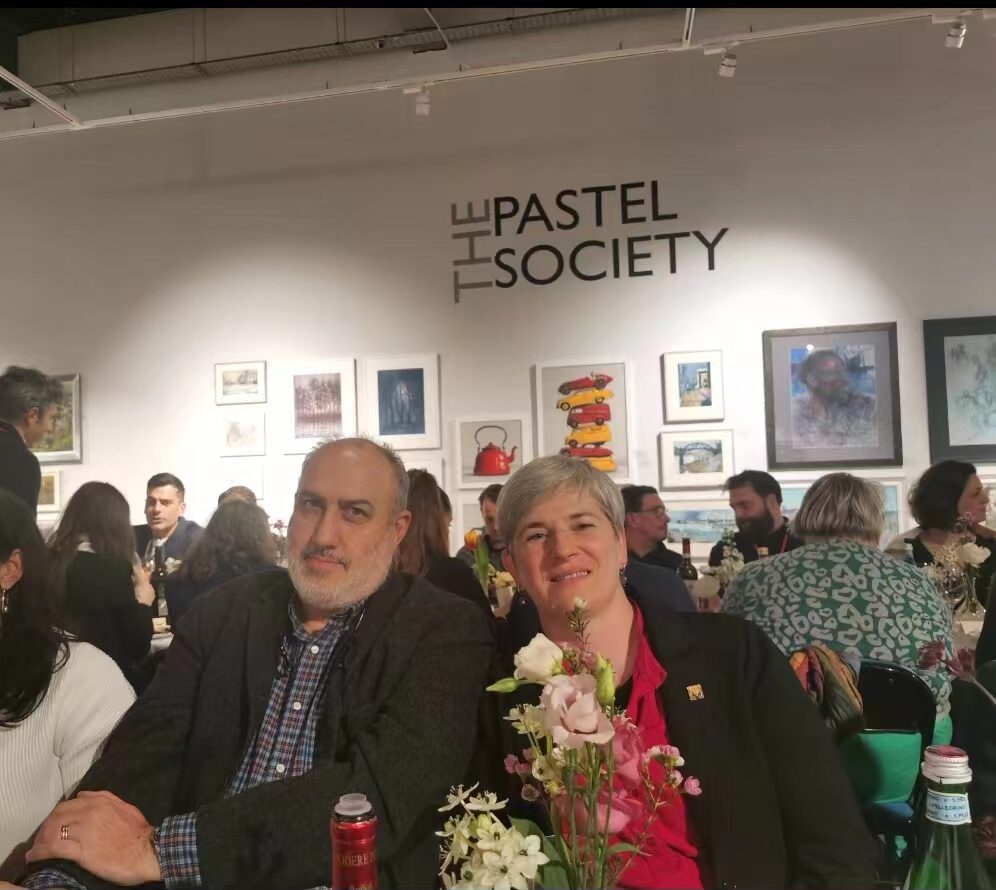
The estate has grown by leaps and bounds over the years: today it counts 21 hectares (shortly to become 23 hectares because of recent land acquisition in Alta Langa). There are ten hectares in Serralunga, distributed among some of the commune’s most famous vineyard districts. These are: Cerretta, the family’s historic vineyard site; Prapò, bought by his parents in 1964 (the year in which they married); the plots in Lazzarito were bought in 2003 from a cousin of his mother’s; and last but certainly not least, the vines in Vignarionda, inherited in 2010 (and that unfortunately needed to be replanted in 2012, given the diseased state of the vines). It is not without interest that practically all of the estate’s holdings in Serralunga are planted to Nebbiolo, with only 0.5 hectares of Barbera used to make their Barbera d’Alba Superiore. By contrast, white grapes dominate in the colder Alta Langa, where Riesling and Chardonnay were planted in 1998; then in 2000 they added Pinot Nero and Chardonnay so as to make the Alta Langa classic method bubblies (by secondary fermentation in the bottle) and finally planted Nascetta and some Nebbiolo too. The goal with the latter grape was to make both a Nebbiolo sparkling wine and a Langhe Nebbiolo. Most importantly, at Ettore Germano they have always replanted their prized vineyard holdings with massal selections from their own vineyards. Sergio’s father Ettore had patiently selected over the years a Nebbiolo Lampia with a smaller, less compact bunch that he quite liked, and that is still the Nebbiolo they replant at the winery. Only in Alta Langa have they tried some nursery clones of Nebbiolo. By contrast, at the estate they have never been big fans of Nebbiolo Rosé and Nebbiolo Michet.
Currently, Ettore Germano produces about 160-170,000 bottles/year (40,000 of five different Barolos; 50,000 bottles of three different Alta Langa Metodo Classico;10,000 bottles of a Nebbiolo metodo classico sparkling wine; 25,000 of the famed Riesling Hérzu; 25,000 bottles of Langhe Nebbiolo, and small numbers of Chardonnay, Nascetta and Barbera d’Alba Superiore.
It might surprise, at first glance, that a “Barolista” of this ilk would be as associated with white and sparkling wine production as much as they are at Ettore Germano. It was during Sergio’s enology studies that he became fascinated by white and sparkling wines. He was also fortunate in that he had trained at estates where such wines had always been made. For example, at Batasiolo they made our first Metodo classico in 1988. And drinking the great wines of France and Italy stimulated him even more to make his own great wines from white grapes. In Sergio’s own words: “And I just love Riesling: when I first tasted good ones, it was like thunder in a bottle, and I personally like to make wines that I like to drink. And so I planted Riesling in 1995 in Serralunga and then in 1998 at Ciglié; then, when I saw that the Alta Langa denomination was being created, I felt that those cool habitats were just the right ones for Riesling and sparkling wine production. In other words, I hope to make wines from the grapes I like but in so doing to give such wines my imprint, or rather, to create a wine that expresses my vision of it.” In his free time, or when with friends, Sergio likes to drink sparkling wines such as Champagne, Trento ed Oltrepo’ Pavese. Still white wines include Riesling obviously, especially the German versions, but also those of Alto Adige and Austria. He also likes some wines of Sancerre, and amongst Italian white wines, he thinks very highly of Verdicchio. Among red wines, he appreciates the wines of Sagrantino and Montepulciano, but also lighter fare such as the Pinot Nero wines of Burgundy and Germany, as well as those of the Valle d’Aosta and Alto Adige. Last but not least, both his wife and him love the wines made with Tempranillo.
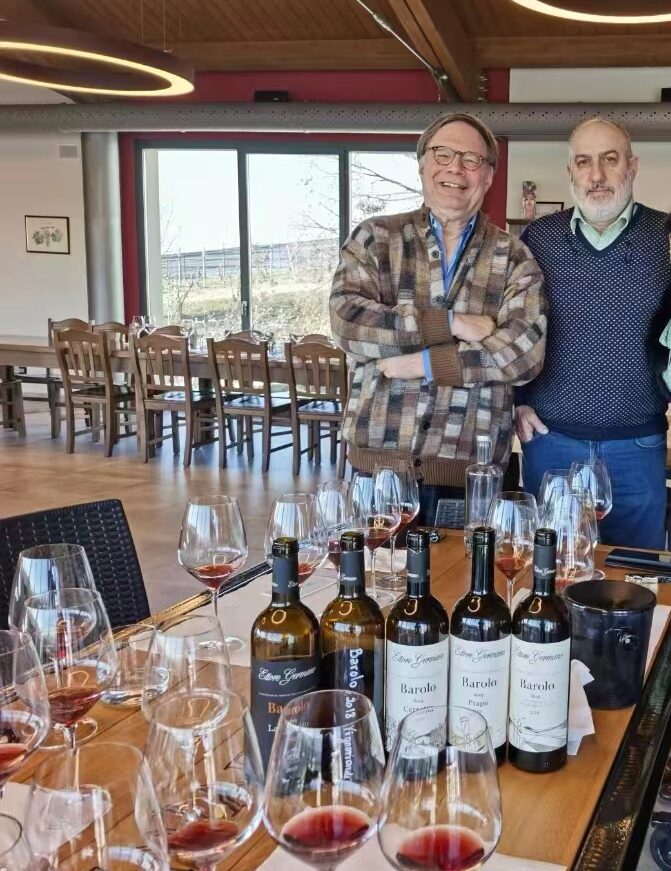
In ultimate analysis, Sergio recognizes that he was twice lucky. First, in that his father always supported his decisions, such as planting white grapes in the Langhe when nobody else was doing so. He clearly wants to be the same kind of father to his own children and is enthusiastic about their presence in the decision-making at the family winery. Second, because he was born in Serralunga, believing that he has a duty and a responsibility to allow this magically endowed land to express its wines in their purest form possible. “I view it as a privilege” he states simply. I’ll just add that the privilege is also ours, when we are lucky enough to taste an Ettore Germano wine.
The wines in this tasting
The wines in this report were tasted at the winery with the Germano family, in London at the Astrum portfolio tasting and in Shanghai, where I live and work.
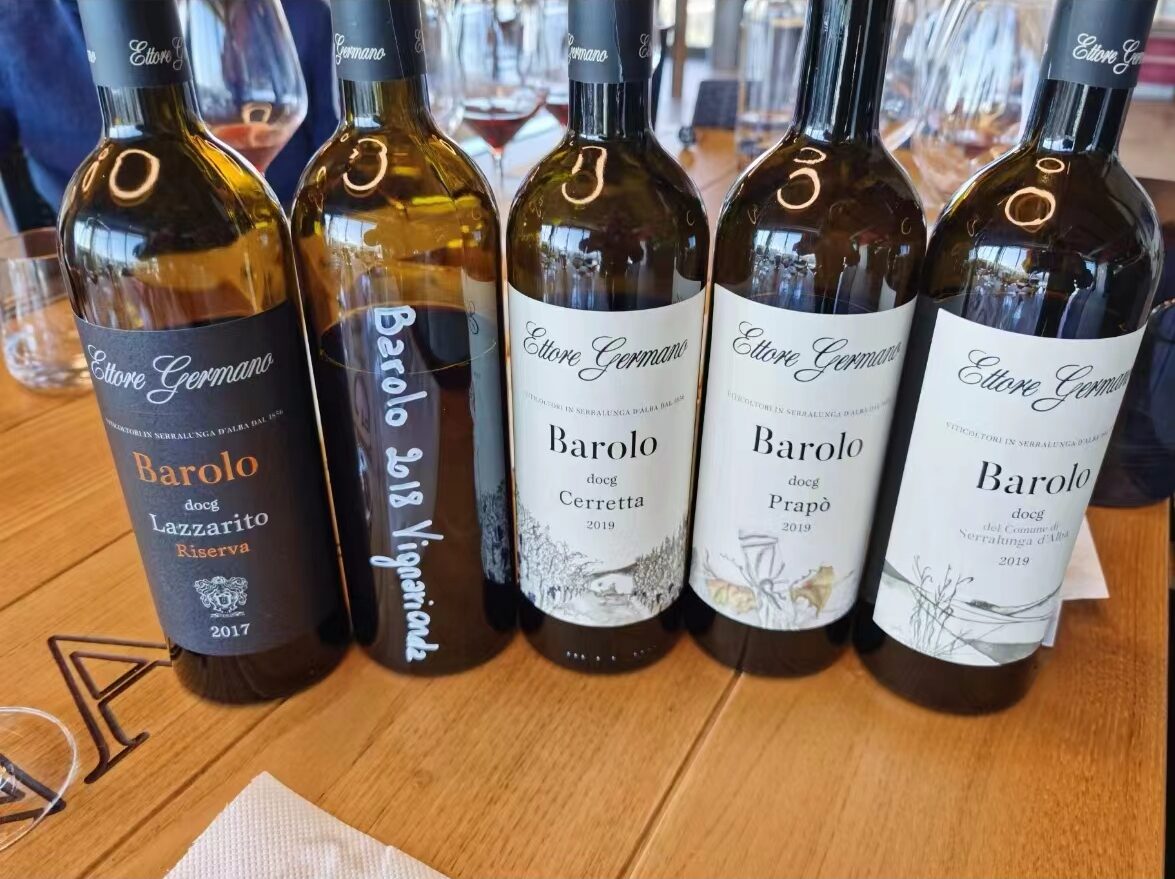
Ettore Germano 2019 Alta Langa Extra Brut 93
Bright pale straw colour. Very fresh, precise and energetic, aromas and flavours of white fruit, white flowers and custard cream. This has sneaky concentration and refinement, with a very long finish that is tapered and pure. Features above average complexity for an Alta Langa (and many other Italian bubblies, for that matter). This is usually stated to be an 80% Pinot Noir and 20% Chardonnay blend, but for precision’s sake, let me tell you that the 2019 is in fact a 75% Pinot Noir and 25% Chardonnay blend (the two varieties are vinified separately) that spent 33 months (not the usual thirty) on the lees. The Chardonnay goes into 500L French oak barrels and Pinot Noir into stainless steel. Drinking window: 2024-2030.
Ettore Germano 2016 Alta Langa Blanc de Blancs Riserva Pas Dosé 91
Lively straw yellow. Nicely ripe aromas of apple, orange and apricot. Then slightly more herbal in the mouth, with nuances of eucalyptus and forest floor accompanying the orchard fruit flavours on the persistent, vibrant finish. Much less oaky than the 2015 Pas Dosé. Drinking window: 2028-2038.
Ettore Germano 2015 Alta Langa Blanc de Blancs Riserva Pas Dos 89
Vivid straw yellow with a tight bead of small bubbles. Oak-dominated aromas and flavours of orchard fruit, botanical herbs and spices. Has a youthfully chewy texture that coats the palate on the medium-long, slightly broad and coarse finish. This might yet develop well, but presently it’s my least favourite of the Ettore Germano Alta Langa wines I tried. It’s a 100% Chardonnay that spent 65 months on the lees (in fact, the number sixty-five is spelled out at the bottom of the front label). Drinking window: 2028-2032.
Ettore Germano 2016 Alta Langa Blanc de Noirs Riserva Pas Dosé 91
Good full medium straw yellow (lighter in hue than the more coppery 2015). Red cherry and berry aromas are currently somewhat camouflaged by an exuberant oakiness, but also lifted by a welcoming fresh citrus nuance. Enters fresh and easygoing, then sturdier and more tannic in the middle, with harmonious acidity nicely framing the ripe juicy red plum and berry flavours. The juicy aftertaste is long and showcases hints of licorice, camphor and herbs. An excellent Alta Langa bubbly that is quite promising, but the vines aren’t at an age yet where they can express the necessary complexity for an even higher score. Drinking window: 2026-2032.
Ettore Germano 2015 Alta Langa Blanc de Noirs Riserva Pas Dosé 94
Coppery-tinged medium straw yellow colour. Concentrated, focused aromas of strawberry, marzipan, vanilla, and woodsy underbrush. Very nicely mellow in the mouth, but with outstanding cut and clarity to the juicy red berry, candied violet and forest floor nuances that linger impressively. A superb Alta Langa made with 100% Pinot Noir that boasts above average complexity and length. Excellent, and even better than I remember it, so I’m upping my score. Drinking window: 2026-2032.
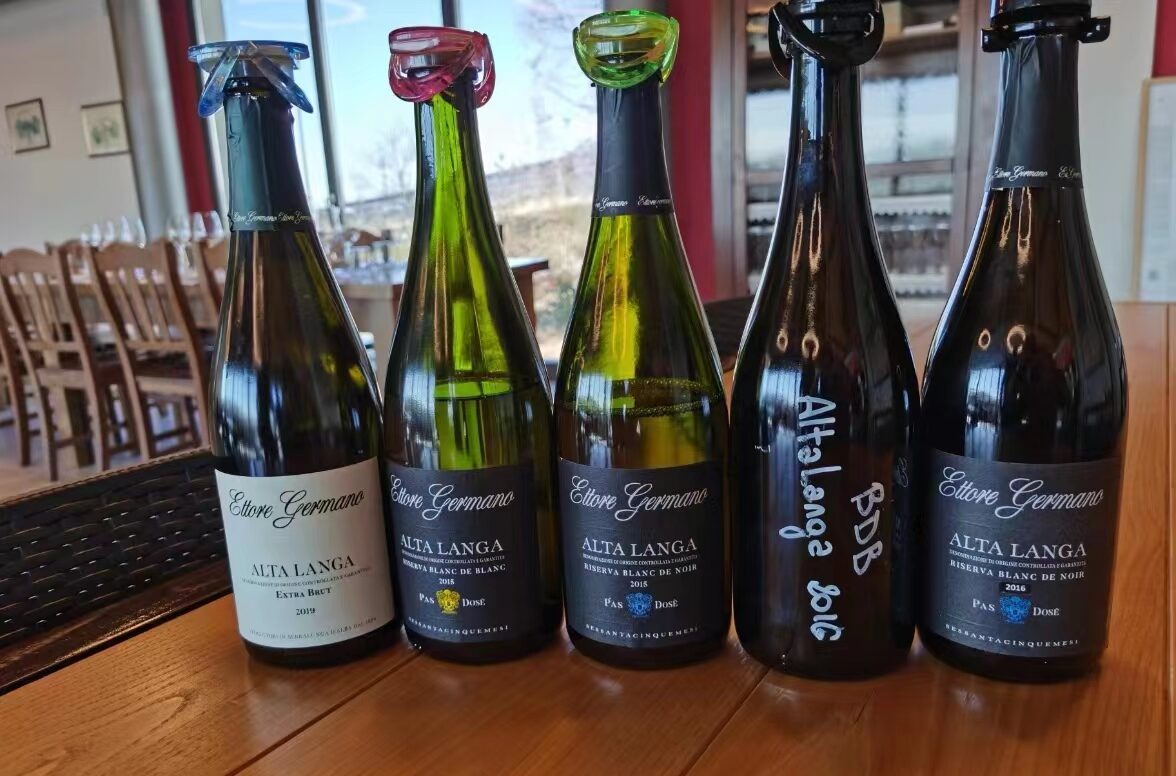
Ettore Germano 2014 Alta Langa Blanc de Noirs Riserva Pas Dosé 91
Bright yellow with amber tinges and a steady stream of small bubbles. Herbs, tangerine and strawberries on the nose and in the mouth. Nicely tapered and broad on the long finish. Boasts the herbal character that is typically also found in many wines of the cooler Alta Langa territory; when not excessive it adds a welcome measure of added freshness, as it is in this case. A 100% Pinot Noir, partly (50%) aged in 500 L French oak tonneaux and the remaining (50%) in stainless steel where it matures for seven to eight months. This spent 65 months on the lees. Drinking window: 2025-2031.
Ettore Germano Extra Brut Rosé Metodo Classico Rosanna 92
Pink orange hue that brings salmon to mind. Orange peel, violet, and cream soda on the nose. Then richly orchard fruity in the mouth, boasting excellent depth and inner-mouth perfume. Finishes long and creamy, clean and very fruity, with a hint of residual sweetness that makes this nicely approachable pink bubbly even easier to like. This is really a knockout Rosato bubbly; a little more complexity and I would have scored this much higher; but that might come with bottle age. 100% Nebbiolo, 80% of which is fermented in stainless steel and the remaining 20% in three and four years old wooden barrels. Aged on the lees for at least eighteen months, the wine is disgorged and topped up with sparkling wine only (in other words, without adding any liqueur: not that there’s any need for it, given how pleasantly creamy-sweet this is as it is). Though it’s a non-vintage wine by label, this is in fact a 2020 vintage wine. Drinking window: 2024-2028.
Ettore Germano 2022 Riesling Hérzu Langhe 91
Pale green-gold colour. Ripe aromas of Red Delicious apple, guava, and star fruit, with only hints of crushed stone and menthol lurking in the background. Then broad and nicely glyceral, but with a slightly strict undertone of green fruit and herbs most likely due to a good percentage of early-picked grapes. A strong note of chamomile and balsamic oils gives the long finish a note of mellowness. This is made with 100% Riesling grown in the territory of Cigliè (in the cooler Alta Langa), on limestone and stony soils, stainless steel fermented and no malo done, it stays about eight months on the lees. Drinking window: 2024-2027.
Ettore Germano 2020 Barolo del Comune di Serralunga 91
Medium red with a garnet tinge. Slightly high-toned aromas of very ripe cherry, kirsch, dried violet, and tobacco. Supple, fat and sweet, with high-toned superripe and mellow set of red fruit, orange peel and saline flavours but with enough acidity to come off as lively and fresh despite the ripeness. The tannins are very suave for the year. The 2020 was made with grapes coming mostly from the Cerretta vineyard but with some from Prapò and Lazzarito as well. Spent two years in 700 liter tonneaux for about two years. Drinking window: 2026-2033.
Ettore Germano 2019 Barolo del Comune di Serralunga 92
Moderately saturated full red. Licorice nuances complement the herbal (rosemary, mint) red cherry and blackcurrant aromas and flavours. A juicy, fruit-driven midweight that boasts excellent intensity to its slightly chewy, rustic red berry and licorice flavours. Finishes long with noble tannins and an emerging mineral element. Good to drink now, but can age a decade easily. The 2019 was made mostly with Nebbiolo grapes from Cerretta and a little from Prapò; unlike the 2020, no grapes from Lazzarito were used to make this wine. Drinking window: 2025-2035.
Ettore Germano 2019 Barolo Prapò 96
Fully saturated bright red. Cool, extremely refined aromas of sour red cherry and menthol are complicated by minerals, cinnamon, nutmeg, leaving a perfumed, sexy impression behind. Then just as beautiful in the mouth, with outstanding energy and inner-mouth violet lift to the penetrating sour red cherry and sweet spice flavours. Closes elegant and long, with plenty of harmonious acidity, floral perfume and an inviting note of red cherry nectar. Very deep, complex Barolo made from vines that are 30 and 55 years old, and aged in 2000-3000 L barrels (part of which are new) for 18-24 months. Unlike other Barolos made from Prapò grapes, Germano’s is somewhat softer and more approachable when young (softer in Serralunga terms, so it’s a very relative softness) which is most likely due to the veins of sand that run between the layers of marl in this specific portion of Prapò (where Germano’s vines are), Drinking window: 2026-2040.
Ettore Germano 2019 Barolo Cerretta 95+
Good bright, dark red. Rich and warm but fresh on the nose, offering big, rich aromas and full-bodied flavours of dark red cherry, licorice, tobacco and violet along with a loamy note. Smooth and fine-grained but still youthfully backward, with harmonious acidity nicely extending the flavours as they spread out on the back end, finishing with building tannins and a hint of sweet spices. This will merit a higher score with a few years of cellaring, hence I’m adding a ‘+’ sign to my original score of 94. Germano’s Cerretta is in the historic heart of the grand cru, and gives a fully structured, full-bodied wine and hence Germano serves it after his Barolo Prapò (at most other estates, it’s usually the other way around). In my experience, the Barolo Cerretta, while never as refined as Germano’s Prapò bottling, is always the bigger and more powerful wine: that’s not due to Germano’s winemaking, but rather is the correct expression of what these two crus can deliver (Cerretta wines are fleshier; Prapò’s are more steely and mineral). In other words, terroir is allowed to speak loud and clear here: so very well done, Mr. Germano. Drinking window: 2028-2040.
Ettore Germano 2018 Barolo Vignarionda 95
Luminous red colour. Explosive, varietally accurate aromas of ripe red cherry, raspberry nectar, sweet spices and pipe tobacco. Then at once penetrating and luscious in the mouth, with very pure and lifted red fruit and sweet spice flavours that linger very impressively on the long, luscious close. This is just a superb Barolo, and it’s that more impressive given it’s from the less than memorable 2018 vintage. 100% Nebbiolo, with no destemmed grapes as Germano likes the freshness that the stalks provide to the finished wine. Drinking window: 2028-2038.
Ettore Germano 2017 Barolo Vignarionda 94
Good full vivid red. Aromas of red cherry, strawberry, licorice, minerals and faded flowers. Juicy and energetic, with a penetrating quality to the concentrated red berry flavours, plus a refreshing citrussy undertone that gives this a light on its feet impression that is uncharacteristic of most of the wines made in this very hot, droughty year. Densely packed but not at all heavy, this harmonious, smooth red features a medicinal reserve to its redcurrant jelly and licorice flavours on the risingly tannic but polished finish. Unlike the Cerretta and Prapò bottlings, the grapes from Vignarionda are pressed but not destemmed, as Germano likes the extra freshness the stalks bring to the finished wine. Drinking window: 2026-2040.
Ettore Germano 2017 Riserva Barolo Lazzarito 96
Good full red. Perfumed aromas of red cherry, redcurrant, plum, sweet pipe tobacco and loam, plus a hint of ferrous minerals. Broad, fresh and laid-back, with outstanding focus and energy for the vintage, this offers red berry, mint and raw meat flavours that are nicely framed by fine-grained tannins (a very impressive accomplishment in the hot and droughty 2017 vintage). Though it can be drunk now, I’d give this at least a few years before pulling the cork. This is superlative wine and showcases the greatness of the Lazzarito cru, in my opinion easily one of the ten best of all Barolo but that has been historically hampered by the lack of a superstar winemaker such as a Giacomo or Aldo Conterno making wine with its grapes. Maybe that will change now with Sergio Germano making some outstanding Lazzarito wines in recent years; the fact his vines grow in the lower part of the cru (at about 300 meters asl) allows for an earlier expression of Lazzarito Barolo in the glass making this wine somewhat less complicated and difficult to understand when young. I can make a good case that in 2017, this wine from Germano is even better than his Vignarionda. Germano bottles his Lazzarito as a Riserva because after spending 24 months in oak it spends another twenty-four in bottle before going on sale. Quite understandably, Germano believes that the double whammy of Lazzarito’s calcareous soils (contributing to powerful tannins) and its sandy layers conferring remarkable finesse require the wine to rest for a longer aging period in bottle. Drinking window: 2027-2045.

 English
English



